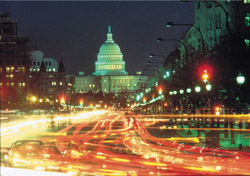
The judge overseeing the Justice Department’s lawsuit to block the American-US Airways merger on antitrust grounds lost no time in responding to the DOJ’s request to delay the trial due to its inability to adequately prepare its case amid the government shutdown.
Request denied.
In dismissing the DOJ’s filing, U.S. District Judge Colleen Kollar-Kotelly argued that postponing the trial “would delay the necessary speedy disposition of this matter. It is essential that the Department of Justice attorneys continue to litigate this case.”
The decision is a win for the airlines, which have been pressing for a speedy resolution to the DOJ complaint.
Texas AG Withdraws Opposition to Merger
In more good news for the would-be merger partners, Texas Attorney General Greg Abbott has withdrawn his state’s support for the DOJ suit.
In a news conference with American, he summarized the settlement terms as ensuring that “the new merged American Airlines will maintain daily service to rural airports across the state of Texas, that thousands of jobs in Texas will be preserved, and that the headquarters for the merged company will remain in the DFW area.”
From his remarks, it can be seen that the Attorney General’s concerns, now mitigated, were focused on the merger’s effects on air service and the 25,000 American jobs in Texas, not on the antitrust issues that are at the heart of DOJ’s complaint. Because of the misalignment with the DOJ complaint, it’s not clear what if any effect Texas’s withdrawal from the case will have.
Antitrust Trial Timeline
If no agreement between the DOJ and the airlines is reached in the interim, the trial to adjudicate the DOJ’s suit to block the merger is set to begin on November 25, and is expected to last for around 10 days. Other related events scheduled to take place in the run up to the trial’s start:
October 25 – Close of fact discovery
October 25 – Plaintiffs’ expert disclosure
October 30 – Final deadline for requests for admissions to be served
November 8 – Defendants’ expert disclosures
November 15 – Supplemental and/or rebuttal expert reports
November 20 – Close of expert discovery
Merger Cheat Sheet
- The new company would retain the “American Airlines” name and be based at American’s Ft. Worth headquarters.
- US Airways chief Doug Parker will be the new CEO. American chief Tom Horton will be named chairman of the new board and remain in that position until the spring of 2014 when the company’s first annual shareholder meeting will be held. When Horton departs the board, Parker will assume his position as chairman.
- American’s creditors would own around 72 percent of the new company; US Airways shareholders would get the rest.
- Based on 2012 results, the new company would have generated $38.7 billion in revenue.
- The merger is expected to generate around $1 billion in combined extra revenue and cost savings for the new company.
- The new company will be valued at around $11 billion.
- Combining the third- and fifth-largest U.S. carriers will create the world’s largest airline, in terms of passenger traffic.
- Prior to any post-merger rationalization, the two airlines will have around 120,000 employees, 950 planes, 6,500 daily flights, and eight major hubs (American: Dallas, Miami, Chicago, Los Angeles, New York; US Airways: Phoenix, Philadelphia, Charlotte). Although the carriers promise to maintain all current hubs, Phoenix and Philadelphia are likely to be downsized in the post-merger “rationalization.”
- The new American will be a member of the oneworld alliance, not the Star Alliance.
- The merger is subject to review and approval by U.S. regulators. That wasn’t expected to be a problem since there is relatively little overlap between the two airlines’ networks.
- The actual merger won’t happen overnight. United and Delta required five and seven months respectively to secure the necessary approvals for their mergers.
- It was 22 months after their merger closed before United and Continental finally merged their frequent flyer programs. Expect a similar post-close interval before American and US Airways consolidate their programs.
- Comparisons between American and US Airways’ current mileage programs are probably moot since there’s a high likelihood that an entirely new revenue-based program (like Southwest’s) will be introduced to replace both programs.
- After the merger, 83% of U.S. domestic air traffic will be in the hands of just four airlines (American 26%, United 19.3%, Delta 19.2%, Southwest 17.3%).
This article originally appeared on FrequentFlier.com.
We hand-pick everything we recommend and select items through testing and reviews. Some products are sent to us free of charge with no incentive to offer a favorable review. We offer our unbiased opinions and do not accept compensation to review products. All items are in stock and prices are accurate at the time of publication. If you buy something through our links, we may earn a commission.
Related
Top Fares From
Today's Top Travel Deals
Brought to you by ShermansTravel
France: 8-Night Paris, Avignon & Nice...
Infinity Worldwide Vacations
 vacation
$2880+
vacation
$2880+
Poconos: 3 Nts in Garden of...
ResortsAndLodges.com
 hotel
$305+
hotel
$305+
7-Nt Canada & New England Cruise,...
Princess Cruises
 cruise
$839+
cruise
$839+



